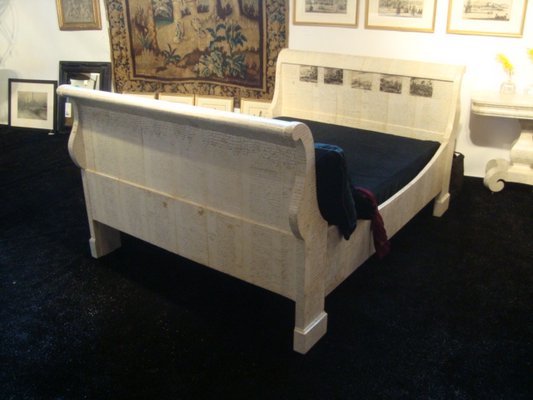
“No one’s buying brown wood antiques anymore and especially the heavy Empire style,” groused Hubert Van Asch Van Wyck. Hubert, known as “Bear,” lamented that Connecticut’s centers for antiques such as Woodbury, Washington and New Preston have been reduced to but a handful of shops. “But as a good businessman, an artist and a dealer who loves this business, I looked at this heavy furniture—and came up with this idea!”
What had stopped me dead in my tracks at the East Hampton Historical Society’s antiques show last week was a magnificent Empire sleigh bed, covered entirely with creamy sheets of paper inscribed with paragraph upon paragraph of beautifully hand-scribed Italian penmanship. The scrolled headboard and footboard appeared almost modern in their simple, elegant forms, as the textured paper and gorgeous writing tucked gracefully around their curves. Finished to a mellow sheen, the surface appeared glazed in glass.
The 1840s and 1850s revived neoclassic forms, but while relishing the new machine-produced furniture and broad, dark surfaces of walnut and mahogany veneer, this period produced clunky interpretations. The resulting Empire and Biedermeier styles have enjoyed their moments in the sun (the 1990s), but have withered on the vine more recently as the Vintage Period’s phoenix has risen.
However, these monumental, simplified forms have gained a new lease on life at the hands of “Bear,” owner of Black Swan Antiques.
Bear, who taught art at the American School in London, employs a technique that he calls “L’arte del povero”—literally translated as “poor man’s art.” He locates handwritten 17th- and 18th-century manuscripts, searching as far as Syria, where he found this Italian one. It was carried by hand out of the war zone into Jordan, and shipped to him in a brown paper bag wrapped in twine. Bear prefers the paper from this period because the wood pulp from which the paper was made has never been dissolved with acid. Therefore the paper has remained white (acid content browns paper as well as anything it comes into contact with). The paper is also more richly textured and malleable.
He then applies the paper with wallpaper paste to the antique’s sanded and primed surface, on which he brushes on several coats of lacquer, wet sanding in between coats. Also called “Lacca Contrfatta,” or counterfeit lacquer, the technique Bear employs is more commonly known as “decoupage.” Bear follows a long line of famous “decoupeurs” (French for “those who cut”) which includes Lord Byron, Marie Antoinette, Beau Brummell, Matisse, Queen Victoria and Picasso.
The art of decoupage traces its roots back to Eastern Siberia before the 12th century, where nomadic tribes cut out felt, and with a mixture of animal skin glue attached it to the tombs of their dead as a symbol of honor and remembrance. The Chinese later on utilized the technique to decorate windows and lanterns—of course the Chinese, ever ahead of the game!
As the Venetians were the greatest traders of the 16th and 17th centuries, they brought this technique from Asia and transformed the art by applying it to furniture. When Louis the 14th was gifted his first piece of genuine red Chinese lacquer, the rage for anything lacquered or “japanned” took hold. But this refined technique’s secret formulas were jealously guarded by the Asians, therefore extremely expensive and extremely desirable. Cheap knockoffs were eventually bound to appear, and they appeared in the form of decoupage.
Decoupage soon became a passion, with court ladies snipping away at drawings from artists of the day and pasting them onto fire screens, hat boxes, wig stands and toiletries. Works by Fragonard, Pillement and Redoute were cut up. Marie Antoinette was known to have sliced up several Bouchers and Watteaus to glue onto her little boites—perhaps another reason they cut off her head. During England’s 18th century, well-bred ladies of leisure had to count decoupage as one of their accomplishments along with sewing, piano playing, language skills and singing in order to become marriage-eligible.
The German printmakers sent boatloads of lithographs to England’s great country houses, where decoupage of Neoclassical images, urns and scenics decorated not only trunks, boxes and furniture, but soon entire rooms. Known as “print rooms,” these halls featured large mythological lithographs glued to brightly colored plaster strung together by garlands of flowers, fruit and pearls. Decoupage became so popular that it literally covered the walls!
The late Victorian age produced a new wave of decoupage artists, cutting out the mass-produced sheets of sweetly colored and embossed paper, pasting and lacquering them not only to screens, chests and lamp bases, but also to their own elaborate scrapbooks—of which Queen Victoria executed several. Familiar to many of you will be the French decoupage offshoot of “potichomania,“ where in order to imitate Dresden or Chinese porcelain, blue and white decorated cutouts of paper were glued to the inside of glass vases. These vases are frequently found used as lamps and are now popular at more bohemian stores such as Anthropologie.
Apart from at Black Swan Antiques, decoupage examples frequented the East Hampton Historical Society antiques show. English Country Antiques imports marvelous chests from a renowned British decoupage artist, and smaller examples are available scattered among our wonderful East End dealers. There even exists a National Guild of Decoupeurs formed in 1972!
There is nothing like objects that are handmade/homemade to personalize one’s abode. And decoupage has that right amount of “Boho” flair to bring your post-hipster home into the twenty-teens. There must be others besides Bear practicing the facile art of decoupage. This is definitely a simple, effective technique that should be re-envisioned as our paperless digital age takes hold and pressed wood pulp becomes only a thing of the past.